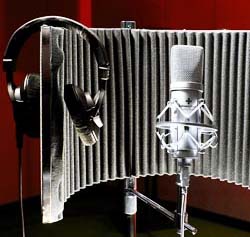
Dialog is the primary sound element around which all other post audio revolves. Unfortunately, a common problem we often encounter is how to prevent music and other sound elements from stepping all over the dialog track so you can understand all the words.
Here’s the secret: You must create a space for the voice track, a kind of hole in the soundtrack, reserved for speech with the music, sound effects, and background audio surrounding but not masking. Here are five tricks of the trade I hope you’ll find useful.
1: Understand that certain frequencies interfere with vocals
Without getting too technical, there are certain instruments that fight with the intelligibility of speech. For the male voice, the lower midrange instruments like acoustic guitar, tenor sax, and the middle of the piano are the culprit. For female voice, the upper range instruments like alto sax, flute, solo violin, and screaming guitar solos tend to cover up and mask intelligibility.
Any music track that predominantly features one of these instruments will conflict with the associated male or female voice. Choose music without these interfering frequencies so there is space for the voice track or be prepared to carefully EQ the music.
For example, if you are using a female voice, avoid music with a hot guitar solo. It might help you to think of the voice track as another solo instrument and select appropriate music that lets you feature it predominantly in the track.
These same rules apply with other sound elements, too. For example, avoid heavy deep bass sound effects if your voice-over is a deep baritone.
2: Choose music that is somewhat sparse
High-powered, high-density tracks work well for visual sequences, but they fight for space (and audience attention) when used under a voice track. In general, the less-is-more school of music is best. Choose music that is full range with a tight low end and crisp highs but with a somewhat reduced midrange.
A well-recorded background sound with deep bass and crisp highs (but with a muted midrange) can effectively anchor the voice in a real space without stomping on the message, too.
Hint: A music track with lyrics will always fight a dialog track. As humans we like to understand what people are saying, and splitting our attention between two separate conversations rarely works (unless you want to confuse the audience for effect).
3: Use stereo balancing to create a hole
If you’re working in stereo make sure there is a hole in the center stereo field for the voice track. This mixing technique requires leaving solo and midrange instruments and sound effects out of the stereo center and balancing them to either the left or right speakers.
This leaves space in the middle for the voice track. Similarly, super wide stereo is a solid trick that can open up the necessary space.
4: Use frequency/tonal controls to create space in mono
Though not as effective as the stereo trick above, you can create a hole by removing the troublesome midrange frequencies with an equalizer. The frequency band that most affects speech intelligibility (male and female) is between 2.5-5 KHz. Reduce the music track by 2-4 dB at those frequencies and correspondingly boost the same frequencies by 2-4 dB on the voice track.
This takes some experimentation to work exactly right, but a little knob diddling and careful listening will show you the way.
5: Automate the other elements by moving them out of the way at crucial times
Volume automation is by far the best way to make sure the sound elements and voice tracks don’t interfere. There’s a reason why all those faders move on your DAW! Lower the music, sound effects, and background when the voice is dominant. Push up the reality during pauses in the dialog. Tweak until it’s all working together.
Also, understand that when you are close to the material, you may understand the spoken words even when buried under competing sounds. To overcome this common phenomenon, play your mixes for others and ask their opinion on whether they can understand the dialog track. If not, adjust your mix accordingly
There you have it, a few ways to make sure your audience can understand what’s being said while still giving them a dynamic ever-evolving soundtrack.
Jeffrey P. Fisher provides audio, video, music, writing, consulting, training, and media production and post-production services for individuals, corporate, and commercial clients through his own company, Fisher Creative Group. He also writes extensively about music, sound, and video for print and the Web and has authored numerous books and training DVD’s.















